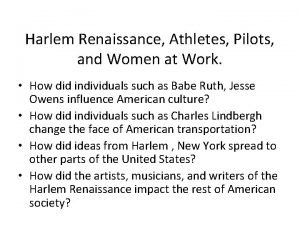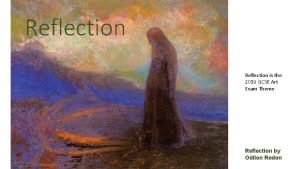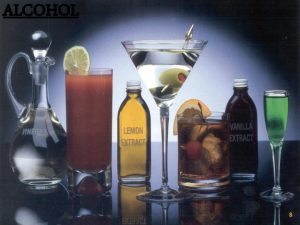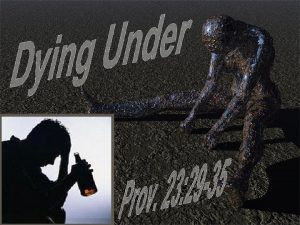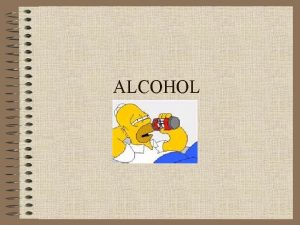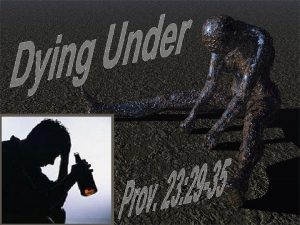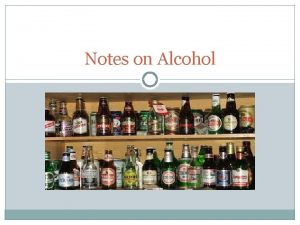Athletes Artists and Alcohol LESSON 2 Can Athletes
























- Slides: 24

Athletes, Artists, and Alcohol LESSON 2

Can Athletes Make a Country Proud? What words describe your feelings when you see Canadian athletes win Olympic medals?

The Golden Age of Canadian Sport Look at p. 86 of the textbook With a maple leaf on his shirt, Percy Williams wins the 100 meter sprint at the 1928 Olympics in Amsterdam, Holland. When Williams also won the 200 -meter, race he was called the greatest sprinter the world has ever seen.

The Golden Age of Canadian Sport Look at p. 86 of the textbook Nicknamed the “Saskatoon Lily” after her Saskatchewan hometown, 1928 Olympic high-jump champion Ethel Catherwood was offered roles in movies but turned them down to study business and piano.

The Golden Age of Canadian Sport Look at p. 86 of the textbook At the Olympics, Bobbie Rosenfeld competed in gear borrowed from her father and brother. Rosenfeld exceled in many sports including basketball, hockey and softball. In 1950, she was named Canada’s top female athlete of the first half of the twentieth century

The Edmonton Grads https: //www. youtube. com/watch? v=qx. Jc. Xs. Fxy. LI

National Pride Do you believe that athletes of the 1920 s inspired the same kind of national pride as the athletes of today? Why or Why not?

The Golden Age of Canadian Sport Complete Use p. 86 or the reading to follow to help Put the following names in the left hand column 1. Percy Williams 2. Ethel Catherwood 3. Bobbie Rosenfeld

The Golden Age of Canadian Sport The 1920 s have been called the Golden Age of Canadian sport. At the time, the sports world was dominated by amateurs, who were not allowed to accept payment or prizes. Professional sports were just getting off the ground. The National Hockey league, for example, had been founded in 1917. Amateur athletes, such as sprinter Percy Williams, were the sports heroes of the day. Williams became Canada’s first Olympic superstar when he blazed his way to gold medals in the 100 and 200 -metre races at the 1928 Olympics. When he travelled home to Vancouver by train, parades and celebrations greeted him in cities across the country.

The Golden Age of Canadian Sport At the 1928 Olympics, women were allowed to compete in track and field for the first time and Canadian women rose to the occasion. Canada’s six-member women’s track team, which included Ethel Catherwood and Bobbie Rosenfeld, brought home two gold, two silver, and one bronze medal. Catherwood thrilled Canadians when she won gold in the high jump. And Rosenfeld placed second in the 100 -metre sprint and led the Canadian women’s team to a gold medal in the 4 X IOO-metre relay.

A Revolution in Canadian Art What similarities and differences do you see between these paintings? Marc-Aurelee Suzor-Cote Claude Monet

A Revolution in Canadian Art What similarities and differences do you see between these paintings and the ones from the previous slide? Lawren Harris Emily Carr

A Revolution in Canadian Art Until the 1920 s, Canadian artists were heavily influenced by what was happening in Europe, which was then the focus of the art world. Canadians often tried to imitate European painters. But some Canadian artists had begun to experiment with new styles. At the heart of this movement were seven Ontario painters who formed a loose association they called the Group of Seven. The original members of the group - Franklin Carmichael, Lawren Harris, A. Y. Jackson, Frank Johnston, Arthur Lismer, J. E. H. Mac. Donald, and F. H. Varley - wanted to paint the Canadian landscape in new ways. Rather than show scenes realistically, they wanted to express the feelings that the landscape inspired in them.

A Revolution in Canadian Art Other artists, such as Emily Carr of British Columbia, began to do similar things. At first, their paintings were so different that many people rejected them. Over time, however, paintings by these artists have become an important part of the Canadian identity.

Show You Know Question Imagine that you are an Canadian in the 1920 s. You are nominating someone to a list of Canadians who have contributed to the country’s growing sense of identity. Would you nominate a sports hero who helped create a sense of national pride or an artist who helped a create uniquely Canadian style of art? Explain the reason for your answer.

The Temperance Movement What does the word Temperance mean? ◦ What does it mean if you temper a piece of metal? Temperance means to cool, or moderate something

Definitions Temperance Movement ◦ A movement of people who were against drinking alcohol Prohibition ◦ Being forbidden to do something ◦ Often refers to times when alcoholic drinks were illegal.

Was the temperance movement doomed to fail? In the early 20 th century, the temperance movement gained ground in North America. “Demon rum” was blamed for many social problems, such as crime, public drunkenness, family violence, and poverty. Temperance societies believed that if people stopped spending money on alcohol, many families would be able to improve their lives.

The Temperance Movement in Canada The Canadian temperance movement peaked during World War I. One province after another passed laws prohibiting alcohol. These laws varied, however, and were often hard to enforce because many Canadians opposed them. They believed that they should be free to choose for themselves whether to drink alcohol People found many ways to get around the laws. Bootleggers people who made and sold illegal alcohol - setup shop, and “blind pigs” and “speakeasies” - places where people could drink alcohol in secret - sprang up.

The Temperance Movement in Canada The temperance laws were unpopular and widely disobeyed. As a result, most provinces voted to repeal them during the 1920 s. To replace the temperance laws, provinces introduced measures to control the manufacture, distribution, and sale of alcohol. This enabled the government to make a great deal of money from taxes on alcohol. Why did so many people believe that temperance laws were a good idea? Why might these laws have been doomed to fail?

Prohibition in the United States In Canada laws on the sale and consumption of alcohol are governed by the provinces. In the United States, some state governments also passed temperance laws. Then, in 1920, the American federal government introduced Prohibition made the manufacture, sale, and transportation of all beer, wine, and spirits illegal everywhere in the United States. This law remained in effect until 1933.

Whiskey Smugglers and Rum Runners Many Americans opposed Prohibition and enterprising Canadians seized the opportunity to feed the American thirst for booze. Smuggling alcohol into the United States became a big business in Canada. Thousands of Canadians made a good living in this industry, and some, such as Samuel Bronfman (Seagram’s Distillery), made millions. On the east and west coasts, booze was secretly shipped to the United States by boat. Inland, trucks sneaked alcohol across the border. And in Ontario, “rum runners” steered speedboats across the Great Lakes to the American side.

Whiskey Smugglers and Rum Runners Smuggling was profitable, but it was also risky - and sometimes violent. If they were caught, smugglers could be thrown in jail. This sometimes led to gun battles with American authorities. Smugglers also had to watch out for rivals, who might try to hijack their cargo. If this happened, they could hardly complain to the police. Canadian officials often turned a blind eye to the smuggling. After all, higher alcohol production meant higher tax revenues. Other Canadians were divided over the issue. Some said the smugglers were nothing but criminal thugs; others viewed them as defenders of people’s freedom of choice.

Building Block Ideas Create a list of events or issues studied in this lesson and think about how you might use these as the focus of diary entries. Suggest how perspectives on the events or issues could vary and jot notes about your ideas on TLS Worksheet 2. 1. 3 – Building Block Ideas
 Athletes vs non athletes academic performance
Athletes vs non athletes academic performance Epoxide reaction with grignard reagent
Epoxide reaction with grignard reagent Oxidation of secondary alcohol to carboxylic acid
Oxidation of secondary alcohol to carboxylic acid Why should teen athletes avoid performance enhancers?
Why should teen athletes avoid performance enhancers? Seven cruel hours of our lives
Seven cruel hours of our lives All athletes have an innate preference
All athletes have an innate preference Athletes suddenly dying
Athletes suddenly dying Famous athletes with osgood schlatters disease
Famous athletes with osgood schlatters disease Athletes body engineers
Athletes body engineers Anthony rizzolo
Anthony rizzolo Fungi characteristics
Fungi characteristics Goal setting theory
Goal setting theory The presence of spectators helps young athletes
The presence of spectators helps young athletes Should college athletes be paid thesis statement
Should college athletes be paid thesis statement Harlem renaissance athletes
Harlem renaissance athletes Chapter 27 the reproductive system answer key
Chapter 27 the reproductive system answer key Simile from stereo hearts
Simile from stereo hearts Chapter 21 lesson 3 the impact of alcohol abuse
Chapter 21 lesson 3 the impact of alcohol abuse Chapter 21 lesson 2 choosing to live alcohol free
Chapter 21 lesson 2 choosing to live alcohol free Scars in society artists
Scars in society artists Shaped canvas frank stella
Shaped canvas frank stella Reflections gcse art
Reflections gcse art Ancient egypt
Ancient egypt Rock latino origin
Rock latino origin Food art gcse
Food art gcse














